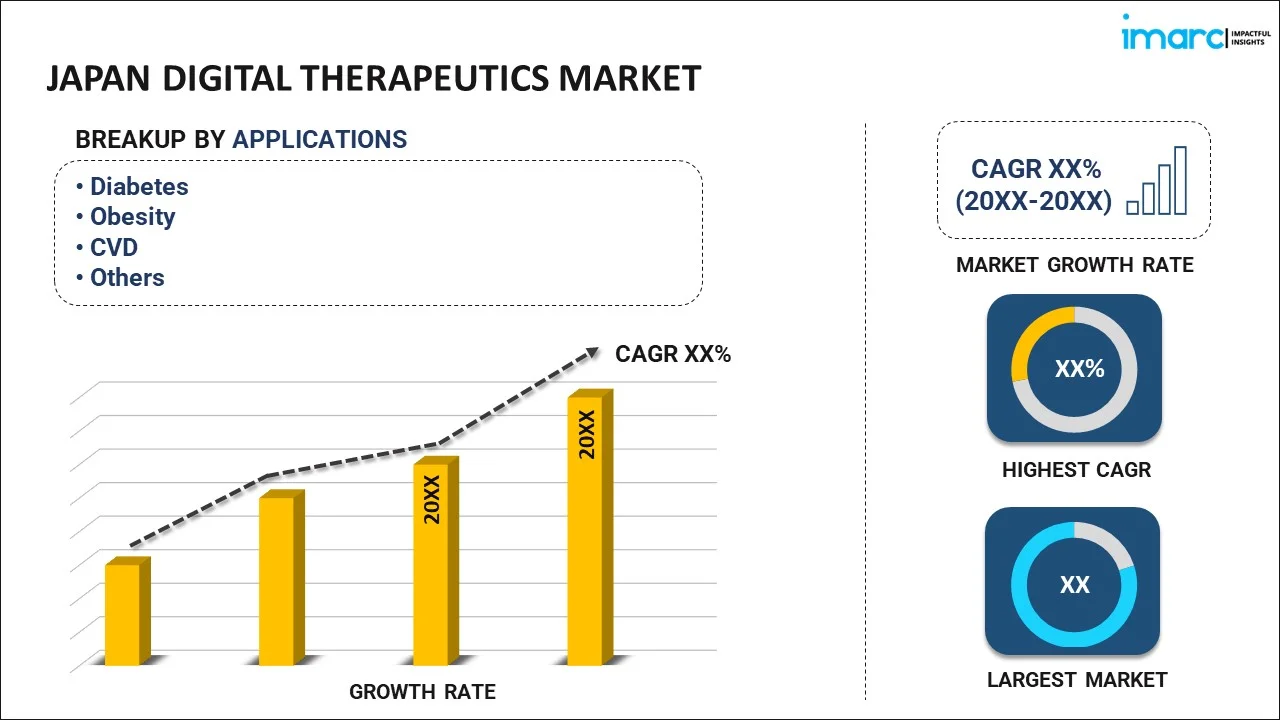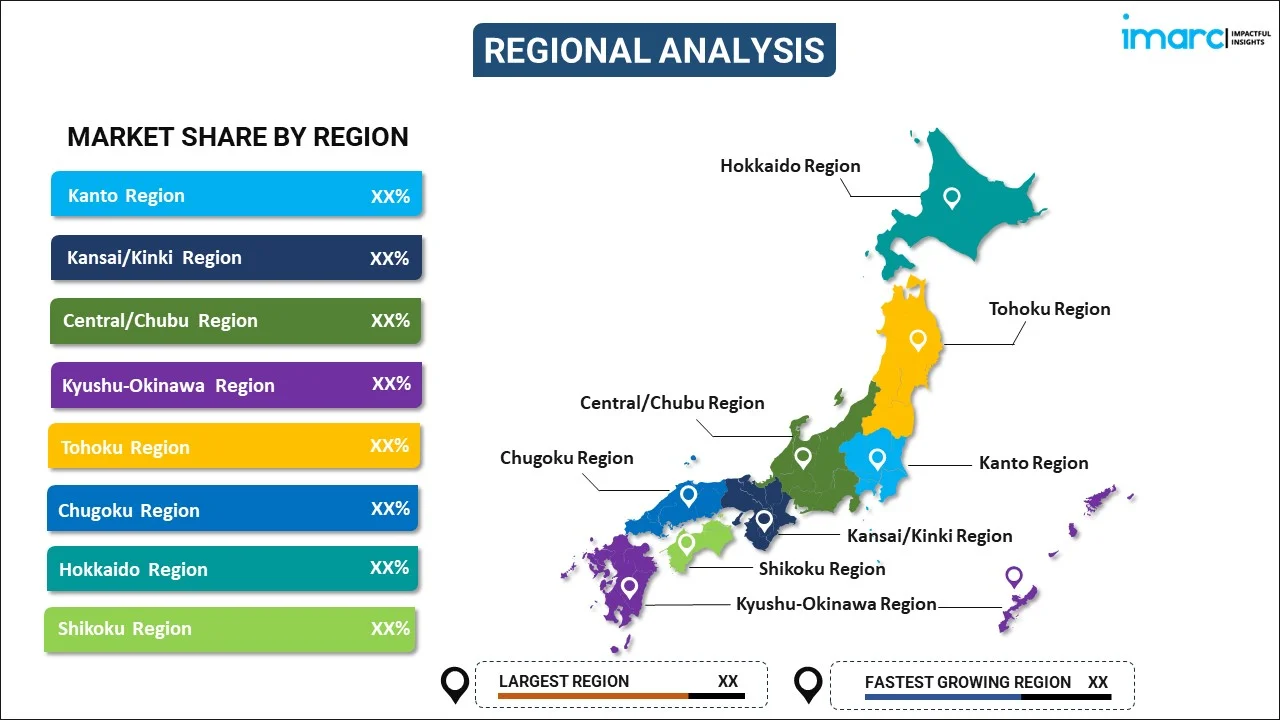
Japan Digital Therapeutics Market Report by Application (Diabetes, Obesity, CVD, CNS Disease, Respiratory Diseases, Smoking Cessation, and Others), End Use (Patients, Providers, Payers, Employers, and Others), and Region 2025-2033
Market Overview:
Japan digital therapeutics market size reached USD 319.5 Million in 2024. Looking forward, IMARC Group expects the market to reach USD 1,924.5 Million by 2033, exhibiting a growth rate (CAGR) of 20.43% during 2025-2033. The growing prevalence of various chronic diseases like arthritis, cardiovascular complications, diabetes, and osteoporosis, rising advancements in artificial intelligence (AI) and machine learning (ML), and increasing establishment of clear guidelines and frameworks represent some of the key factors driving the market.
|
Report Attribute
|
Key Statistics
|
|---|---|
|
Base Year
|
2024
|
|
Forecast Years
|
2025-2033
|
|
Historical Years
|
2019-2024
|
| Market Size in 2024 | USD 319.5 Million |
| Market Forecast in 2033 | USD 1,924.5 Million |
| Market Growth Rate 2025-2033 | 20.43% |
Digital therapeutics are software-based interventions designed to bring about positive health outcomes by modifying patient behavior and providing clinical support. They comprise behavioral therapy apps, which focus on modifying behavior patterns to address mental health conditions, such as stress, anxiety, and depression. They also include chronic disease management platforms, which help patients monitor and manage their conditions through features like medication reminders, activity tracking, and personalized health recommendations. They encompass remote patient monitoring, which involves the use of wearable devices and sensors to monitor the vital signs and health metrics of patients remotely. They rely on scientific evidence and clinical trials to ensure their effectiveness. They often undergo rigorous testing to validate their impact on specific health outcomes. They prioritize user engagement by providing personalized and interactive experiences. They may include features like real-time feedback, progress tracking, and user-friendly interfaces. Digital therapeutics are designed to complement traditional healthcare approaches. They can integrate with electronic health records (EHRs) and connect patients with healthcare providers for seamless coordination of care. They are useful for post-surgery recovery, chronic disease management, and eldercare. They increase access to healthcare by providing convenient and cost-effective solutions. Digital therapeutics can offer a cost-effective alternative to traditional treatments.
Japan Digital Therapeutics Market Trends:
At present, the increasing demand for digital therapeutics as they contribute to better health outcomes by actively involving patients in their care and continuously monitoring and personalized interventions represents one of the crucial factors impelling the growth of the market in Japan. Besides this, the rising prevalence of various chronic diseases like arthritis, cardiovascular complications, diabetes, and osteoporosis is driving the adoption of innovative and effective treatment modalities. Digital therapeutics addresses the increasing burden of chronic illnesses due to its ability to deliver personalized and remote interventions. In addition, the growing advancements in technology, particularly in the realms of artificial intelligence (AI) and machine learning (ML), are empowering digital interventions to analyze vast datasets, personalize treatment plans, and continuously adapt to individual patient needs. The integration of wearables, sensors, and other connected devices further enhances the capability of digital therapeutics to collect real-time health data, providing clinicians with valuable insights for informed decision-making. Apart from this, the increasing shift towards value-based care models and a focus on preventive healthcare is accelerating the adoption of digital therapeutics as a cost-efficient strategy for managing chronic conditions in the country. Regulatory bodies, patients, and healthcare providers are also recognizing the economic benefits of investing in digital interventions that not only treat but also prevent the exacerbation of chronic diseases. Additionally, the rising establishment of clear guidelines and frameworks for digital therapeutics approval and integration into mainstream healthcare is supporting the market growth in the country.
Japan Digital Therapeutics Market Segmentation:
IMARC Group provides an analysis of the key trends in each segment of the market, along with forecasts at the country level for 2025-2033. Our report has categorized the market based on application and end use.
Application Insights:

- Diabetes
- Obesity
- CVD
- CNS Disease
- Respiratory Diseases
- Smoking Cessation
- Others
The report has provided a detailed breakup and analysis of the market based on the application. This includes diabetes, obesity, CVD, CNS disease, respiratory diseases, smoking cessation, and others.
End Use Insights:
- Patients
- Providers
- Payers
- Employers
- Others
A detailed breakup and analysis of the market based on the end use have also been provided in the report. This includes patients, providers, payers, employers, and others.
Regional Insights:

- Kanto Region
- Kansai/Kinki Region
- Central/ Chubu Region
- Kyushu-Okinawa Region
- Tohoku Region
- Chugoku Region
- Hokkaido Region
- Shikoku Region
The report has also provided a comprehensive analysis of all the major regional markets, which include Kanto Region, Kansai/Kinki Region, Central/ Chubu Region, Kyushu-Okinawa Region, Tohoku Region, Chugoku Region, Hokkaido Region, and Shikoku Region.
Competitive Landscape:
The market research report has also provided a comprehensive analysis of the competitive landscape. Competitive analysis such as market structure, key player positioning, top winning strategies, competitive dashboard, and company evaluation quadrant has been covered in the report. Also, detailed profiles of all major companies have been provided.
Japan Digital Therapeutics Market Report Coverage:
| Report Features | Details |
|---|---|
| Base Year of the Analysis | 2024 |
| Historical Period | 2019-2024 |
| Forecast Period | 2025-2033 |
| Units | Million USD |
| Scope of the Report | Exploration of Historical Trends and Market Outlook, Industry Catalysts and Challenges, Segment-Wise Historical and Future Market Assessment:
|
| Applications Covered | Diabetes, Obesity, CVD, CNS Disease, Respiratory Diseases, Smoking Cessation, Others |
| End Uses Covered | Patients, Providers, Payers, Employers, Others |
| Regions Covered | Kanto Region, Kansai/Kinki Region, Central/ Chubu Region, Kyushu-Okinawa Region, Tohoku Region, Chugoku Region, Hokkaido Region, Shikoku Region |
| Customization Scope | 10% Free Customization |
| Post-Sale Analyst Support | 10-12 Weeks |
| Delivery Format | PDF and Excel through Email (We can also provide the editable version of the report in PPT/Word format on special request) |
Key Questions Answered in This Report:
- How has the Japan digital therapeutics market performed so far and how will it perform in the coming years?
- What has been the impact of COVID-19 on the Japan digital therapeutics market?
- What is the breakup of the Japan digital therapeutics market on the basis of application?
- What is the breakup of the Japan digital therapeutics market on the basis of end use?
- What are the various stages in the value chain of the Japan digital therapeutics market?
- What are the key driving factors and challenges in the Japan digital therapeutics?
- What is the structure of the Japan digital therapeutics market and who are the key players?
- What is the degree of competition in the Japan digital therapeutics market?
Key Benefits for Stakeholders:
- IMARC’s industry report offers a comprehensive quantitative analysis of various market segments, historical and current market trends, market forecasts, and dynamics of the Japan digital therapeutics market from 2019-2033.
- The research report provides the latest information on the market drivers, challenges, and opportunities in the Japan digital therapeutics market.
- Porter's five forces analysis assist stakeholders in assessing the impact of new entrants, competitive rivalry, supplier power, buyer power, and the threat of substitution. It helps stakeholders to analyze the level of competition within the Japan digital therapeutics industry and its attractiveness.
- Competitive landscape allows stakeholders to understand their competitive environment and provides an insight into the current positions of key players in the market.
Need more help?
- Speak to our experienced analysts for insights on the current market scenarios.
- Include additional segments and countries to customize the report as per your requirement.
- Gain an unparalleled competitive advantage in your domain by understanding how to utilize the report and positively impacting your operations and revenue.
- For further assistance, please connect with our analysts.
 Inquire Before Buying
Inquire Before Buying
 Speak to an Analyst
Speak to an Analyst
 Request Brochure
Request Brochure
 Request Customization
Request Customization




.webp)




.webp)












